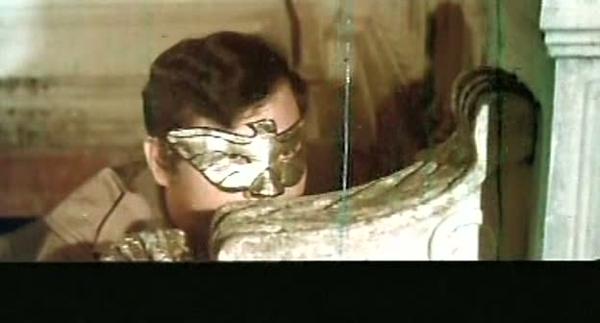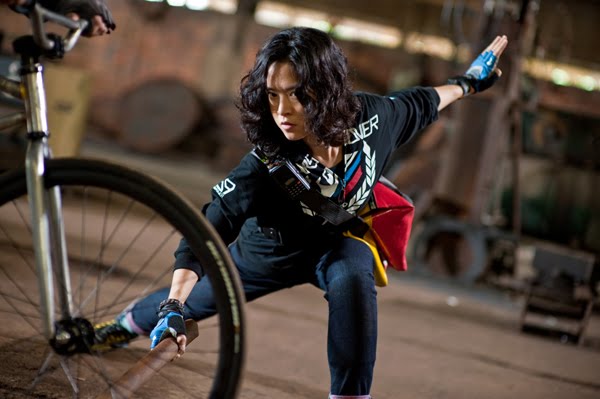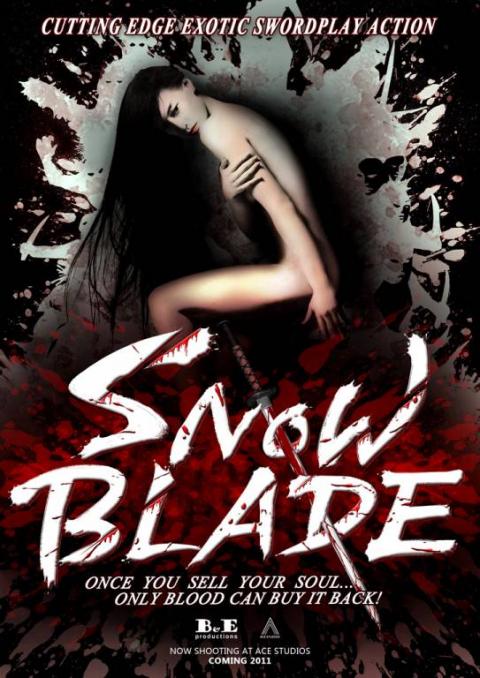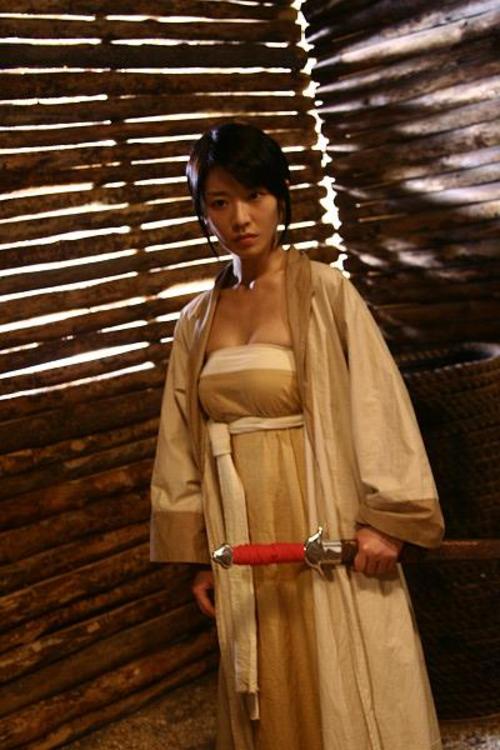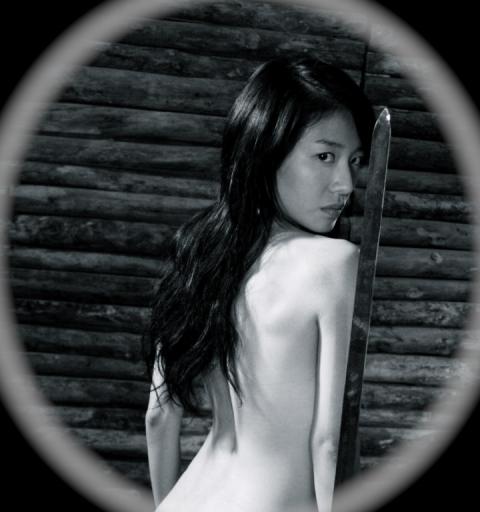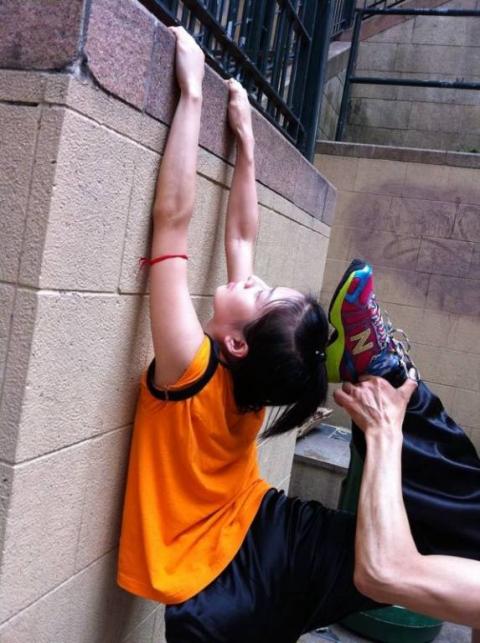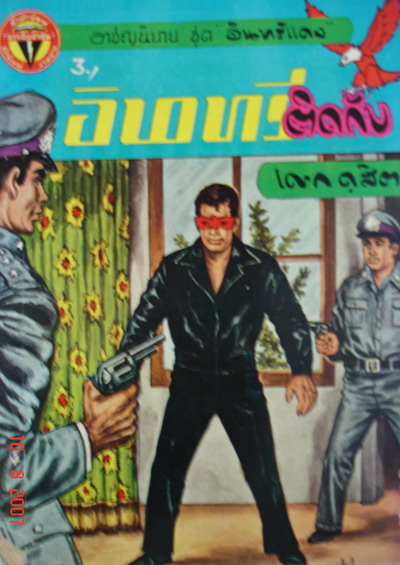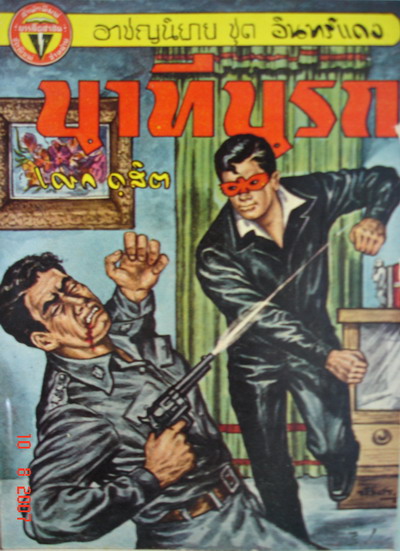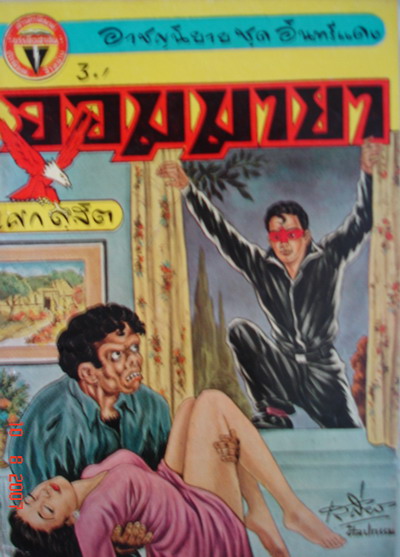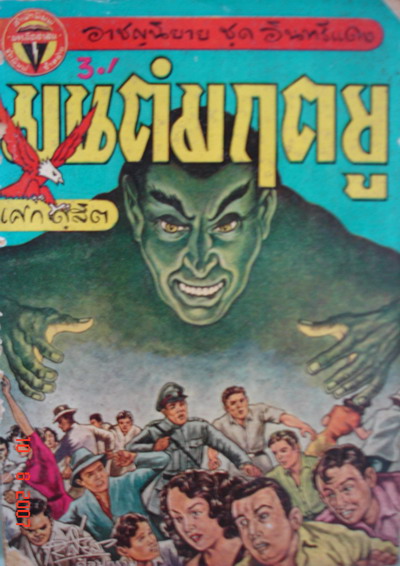Insee Thong
aka Golden Eagle

1970![]()
Directed by Mitr Chaibancha

Insee Thong is a legendary film in the annals of Thai cinema, and would be legendary even if lead actor Mitr Chaibancha hadn’t died filming the last scene of the film. As we’ve seen in our reviews of Awasan Insee Daeng and Jao Insee, the Insee Daeng/Red Eagle films have been increasing in pace, scope, and vision. The villains Insee Daeng faces become more Bond villainesque, and the secret conspiracies are grander, more dangerous, and better armed. In Insee Thong, a gang of communists are using Insee Daeng’s persona and a mad scientist hypnotist to assassinate journalists, while their group prepares to overthrow the government of Thailand. To combat them, Insee Daeng becomes a new hero, Insee Thong (Golden Eagle), and sets out to bring down the gang, clear his name, take out the impostor, and once again save the day.
Insee Thong (and most other Thai films of this era) was shot on 16mm color reversal stock with no synchronised sound, meaning the sound was added live as the films played by film dubbers employed by the regional theater house. Dubbers would follow the script for the most part, but were known to add regional references and topical humor. Some of the film dubbers became famous in their own (similar to how playback singers in Indian film become famous in their own right), Sin Sibunruang aka Tit Khiaw being the first famous dubber. Local dubbing continued until somewhat recently in some regional theaters. You can see Thai film dubbers at work in movies such as Monrak Transistor and Bangkok Loco.

Older Thai films have a distinctive look due to their 16mm reversal film stock origins. The reversal film stock keeps some colors longer than most other types of film, and when the films look washed out they still have vivid colors. There isn’t really another group of film that looks like it. The 16mm film means there was never an original negative, so there is nothing in archives except old scratched up 16mm prints, if anything at all. Most prints where projected until the stock was dead, and any surviving prints were scratched to hell and back. Luckily, Insee Thong is a particularly popular film so a lot of copies were made, causing the surviving prints to not be as scratched up as usual.
The limited amount of original prints the producers made were distributed around the country, both to cinemas and to traveling exhibitors who would project the film onto sheets from the back of a truck in rural areas. Some of these stories remind me of the old US drive-in circuit and stories from David Friedman, as well as some of the tales of how low budget horror is done in India.

From ThaiWorldview, here are the three kinds of open-air cinema:
- Nang kai ya (หนังขายยา) – promotional shows by traveling herbal-medicine salesmen at temple gatherings. Informally called “movies to sell drugs”.
- Nang lom pha (หนังล้อมผ้า) – shown in conjunction with a big feast. Dinner and a movie!
- Nang klang plaeng (หนังกลางแปลง) – special event open-air shows, usually free due to a sponsor and timed with events such as funerals.
The studio system in Thailand at the time consisted of pumping out hundreds of films a year, as there was no TV to take up the entertainment slack. Movie stars such as Mitr and Petchara Chaowarat would film dozens of films simultaneously, sometimes moving non-stop from set to set working all day and getting no sleep. These were called klang plang films, and the half-dozen big stars like Mitr couldn’t even change their hairstyles, because it would affect multiple films. Some companies would combine parts of worn out prints with the same stars into new films, and give a new script to the dubbers. And sometimes the dubbers and theaters would do it on their own!

Mitr Chaibancha appeared in 1/3 to 1/2 of the movies made each year between 1958-1970. Exact numbers are not known due to scattered record keeping from the frantic pace of filming. Mitr and Petchara Chaowarat were the leading couple during the 1960s. Their luk thung musical Monrak luk thung played in cinemas for six months. Nang rim maung (หนังริมเมือง) is a term referring to films that make more money in the suburban areas than the urban cities. Many modern Thais look down on these old films, derisively calling them nam nao (น้ำเน่า) – stinky water. This term even applies to the cheap action films from the 1970s and 1980s. The films from this era did inspire director Wisit Sasanatieng to make Tears of the Black Tiger, and we all know he then went on to direct the disappointing reboot of Insee Daeng (more on that in the Insee Daeng 2010 review!)
Mitr Chaibancha’s death on Oct 8, 1970, lead to the incompletion of at least 20 films (I’ve seen estimations of almost 40!), most of which were junked or quickly finished with doubles for Mitr. As those films were using the 16mm reversal film stock, the death of Mitr lead to a transformation of the Thai film industry, so when production companies regrouped and began to promote new talent, they had switched to 35mm film with synch sound.
Successors to Mitr Chaibancha include Sombat Metanee and then Sorapong Chatree. Petchara Chaowarat was followed by Aranya Namwong as the next big box office draw. Other names of note are Pitsamai Wilaisak, Yodchai Meksuwan, Jarunee Suksawat (who stars in Insee Payong), and the last superstar couple, Santisuk Promsiri and Jintara Sukapat. By the 1990s, most Thai stars had moved to tv drama soap operas called lakorn toratat (ละครโทรทัศน์). But those decades are stories best told in reviews of films from those periods. There has been some resurgence in Thai film this past decade, largely led by Panna Rittikrai/Tony Jaa/Jeeja Yanin martial arts movies, but also spillover from the Asian horror boom, a few big budget action spectacles, and some intellectual/art house films.
 |
|
He’s dead, Jim
|
So let’s get to Insee Thong! Insee Thong is awesome, and I don’t say that lightly. It is a good introduction to Thai action films, and holds up pretty well 40 years later with its quick pace and near-constant action. There is plenty of weird cool stuff going on, and you won’t be disappointed. Insee Daeng must deal with an impostor working for the communist Red Bamboo gang (it is never addressed if it is the same Red Bamboo gang as the ones in Godzilla vs. the Sea Monster, but I’ll just declare it so and that makes the Red Bamboo the unluckiest communist gang ever.
By now age is starting to show on Mitr Chaibancha, he looks a bit out of shape, less trim than his previous outings. But he’s still physically fit enough to run around and shoot people and seduce women. For more information on Mitr Chaibancha, you can check out the best biography in English I’ve seen at the Bangkok Post. We’ve also included a gallery of photos at the bottom of this review.
 |
|
Women have more spots than leopards!
|
This release has subtitles? I’m so confused…now I’ll know what’s going on!

|



